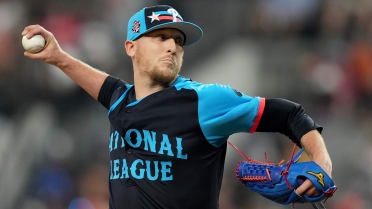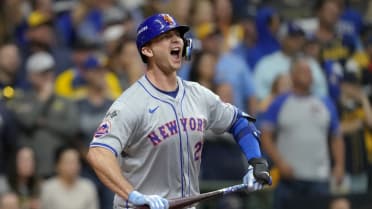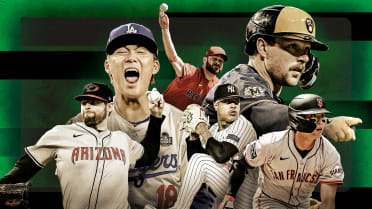Mo (Unanimous!), Edgar, Doc, Moose elected to HOF
Mariano Rivera stands alone in National Baseball Hall of Fame history as the only player ever voted in unanimously by the Baseball Writers' Association of America. But he'll be far from alone on the induction day dais, as the BBWAA has selected four players for entry into the hallowed Hall.
Rivera, Roy Halladay, Edgar Martinez and Mike Mussina were revealed Tuesday night as the third four-man BBWAA-voted Hall of Fame class in the past five years but only the fifth in history. Combined with the selections of Harold Baines and Lee Smith by the Today's Game Era Committee in December, it'll be a six-man class for the July 21 induction ceremony in Cooperstown, N.Y. -- the second six-man group in as many years and the third this decade.
• Complete 2019 Hall of Fame election results | Full coverage
The late Halladay (363 votes, 85.4 percent) joins Rivera as a first-ballot entrant, just one year after his tragic death in an airplane crash. They are the 55th and 56th players voted in on their first ballot. Martinez (363 votes, 85.4 percent), on the other hand, has been elected in his 10th and final year on the BBWAA ballot, and Mussina (326 votes, 76.7 percent) made it on his sixth try.
But the man named "Mo," universally regarded as the greatest closer the game has ever seen, achieved something unprecedented by getting the check mark on all 425 ballots cast. Prior to Rivera, the player who had come closest in a voting process that dates back to 1936 was Ken Griffey Jr., who appeared on 437 of 440 ballots cast in 2016.
"Amazing, amazing," Rivera said on the MLB Network broadcast. "It was a beautiful, long career with what is, for me, the best organization in baseball, the Yankees. To end up like this is amazing. One thing I always remember is wearing No. 42, representing Mr. Jackie Robinson, who, I assume, was the first No. 42 elected. And me, being the last player to wear No. 42 and be elected to the Hall of Fame unanimously is amazing. All I can say is thank God for that."
Though traditionally stingy when it comes to Hall passes, the BBWAA has now voted in 20 players over the last last six years -- the largest total of any six-year span. As always, to be elected, players had to be included on 75 percent of the ballots submitted by voting members of the BBWAA, who had a maximum of 10 slots to fill.
Beyond the entrants, some notable numbers from the 2019 results include a surge in support for Larry Walker (from 34.1 percent last year to 54.6) in his penultimate year on the ballot, and for Curt Schilling (from 51.2 percent to 60.9) in his sixth appearance. Controversial candidates Roger Clemens (from 57.3 to 59.5) and Barry Bonds (from 56.4 to 59.1) saw a slight uptick from their 2018 totals but will have to finish with a flourish in their final three years on the ballot.
Schilling, Walker, Bonds and Clemens were the only non-inductees to appear on more than half of the ballots cast. Fred McGriff finished with a 39.8 percentage in his last year on the ballot.
The Hall of Fame now has 329 elected members, including 232 players, of which 132 have come through the BBWAA ballot.
Here's more on this year's BBWAA class:
RIVERA
Team: Yankees, 1995-2013
Defining stats: 652 saves, the most all-time; 0.70 ERA in 141 postseason innings, the lowest ERA of any pitcher with at least 30 postseason innings; recorded the final out of the World Series four times
You wouldn't have known it when he was signed as an amateur out of a modest Panamanian fishing village in 1990. You wouldn't have known it when he went 3-3 with a 5.94 ERA in 10 starts in '95. You certainly wouldn't have known it when he blew three of his first six save chances in '97.
But thanks to the discovery of a devastating cutter, Rivera became not only the greatest closer in baseball history, but, statistically, the game's greatest run preventer, period. Per Baseball Reference, nobody with at least 1,000 career innings has a better park- and league-adjusted ERA+ than Rivera's 205 mark (105 percent better than average) -- and it's not even close (Clayton Kershaw is second, with a 159).
It is a testament to Rivera's success that we remember his greatest failures. We remember the home run he gave up to Sandy Alomar Jr. in the 1997 American League Division Series, the game-winning hit he allowed to Luis Gonzalez in Game 7 of the 2001 World Series and the blown save that breathed new life into Boston in Game 4 of the 2004 AL Championship Series because they were such extraordinary blips on an otherwise resplendent radar. The graceful way the classy and professional Rivera endured those failures is a part of his legacy, too.
In an especially tumultuous role prone toward personnel changes, Rivera, a 13-time All-Star, was as reliable in his farewell season at age 43 as he had been 16 years earlier. Entering to the sounds of Metallica's "Enter Sandman," he routinely put games to bed, and his first-ballot selection was a foregone conclusion.
"I hope the people in Panama are celebrating the way I am celebrating now because this belongs to Panama," Rivera said. "Just being the second player [from Panama, joining Rod Carew] that reached that plateau, I'm grateful."
HALLADAY
Teams: Blue Jays, 1998-2009; Phillies, 2010-13
Defining stats: Two-time Cy Young Award winner (2003, '10); one of only two pitchers to throw a postseason no-hitter; one of only six modern-era pitchers with at least 200 wins (203) and at least a .650 winning percentage (.659)
One year after his tragic death in an airplane crash in the Gulf of Mexico at age 40, Halladay is rightly remembered for the undeniable and indefatigable excellence he brought to the Major League mound.
Halladay's wife, Brandy, released the following statement:
"Being inducted into the Baseball Hall of Fame is every boy's dream. To stand on that stage in Cooperstown and deliver your acceptance speech in front of baseball's most enthusiastic fans is something that every baseball player aspires to achieve, and Roy was no exception. It was not his goal to have those three letters after his signature. His goal was to be successful every single day of his 15-year career. Tonight's announcement is the end result of that effort. If only Roy were here to personally express his gratitude for this honor, what an even more amazing day this would be. I would like to extend special thanks to the baseball writers for the overwhelming percentage of votes that Roy received in his first year on the ballot. It means so much to me, [and sons] Braden and Ryan."
After overcoming some early-season stumbles in 2001 that necessitated a drastic demotion from the big leagues to Class A Dunedin to rebuild his delivery, Halladay emerged as a workhorse who earned a reputation as one of the game's fiercest competitors. From 2002-11, there wasn't a more dominant starting pitcher in baseball. In that 10-season span, he ranked first in the Majors in wins (170), winning percentage (.694), shutouts (18) and complete games (63, 30 more than the next-closest competitor). His nickname "Doc" was not just a callback to the Old West figure Doc Holliday but a fitting descriptor for his surgeon-like precision on the mound.
Halladay, a first-round Draft pick in 1995, led his league in innings pitched four times and in complete games seven times. He was an eight-time All-Star.
His zenith was the 2010 season, after he was dealt to Philadelphia in a winter trade. In addition to a unanimous selection for the National League Cy Young Award, Halladay threw a perfect game against the Marlins on May 29 and then, on Oct. 6 in Game 1 of the NL Division Series against the Reds, joined Don Larsen as the only pitchers to hold an opponent hitless for an entire game on the postseason stage. Halladay became the first pitcher to throw a perfect game and another no-hitter in the same year.
MARTINEZ
Teams: Mariners, 1987-2004
Defining stats: One of only 10 players in MLB history with 300 or more homers, 500 or more doubles and 1,000-plus walks with an average over .300 and an on-base percentage over .400
Were it up to Rivera, who once referred to Martinez as "the only guy that I didn't want to face in a tough situation," this selection would have come a long time ago. But Edgar had to endure an agonizing wait, appearing on just 36.2 percent of ballots in his first year of eligibility in 2010, bottoming out at 25.2 in '14 and then slowly but surely, with the help of many advocates, rising up to the point of finally crossing the 75-percent threshold after finishing just 20 votes shy a year ago.
"I didn't have control over people's opinions," Martinez said. "I kind of just hoped that things will change over time, and over time, it did change. Some of the sabermetrics really helped."
Then again, Martinez already knew the value of patience. He didn't become a big-league regular until 1990, at the age of 27. He won the AL batting title two years later. But after injuries limited him to 131 games total in 1993-94, he made the full-time move to designated hitter in his age-32 season in '95, and his career blossomed. Over the next 10 seasons, he compiled an adjusted OPS+ that was 53 percent better than the league average.
Though he didn't overwhelm with his home run total (309), Martinez was one of the purest hitters of his day. He is one of only 11 players (minimum 3,000 plate appearances) to post at least a .312 batting average and a .418 on-base percentage -- and the only one who debuted after World War II. He walked (1,283) more times than he struck out (1,202). His defining moment came in the 1995 ALDS against the Yankees -- a series in which he reached base 18 times in five games -- when he doubled home the tying and winning runs in the bottom of the 11th to send Seattle to the ALCS for the first time in franchise history.
Martinez so ably demonstrated the possibility of the bat-only position that the league named its annual outstanding designated hitter award after him. Now, he joins Frank Thomas and the newly elected Baines as the only players in the Hall who logged at least half of their career plate appearances as a DH.
"It's a position where the DH can help the team like any other position, especially relievers," Martinez said. "I think the fact that Harold Baines and me got in this year will help the future of DHs for years to come."
MUSSINA
Teams: Orioles, 1991-2000; Yankees, 2001-2008
Defining stats: 270 wins are tied for 33rd-most all-time and are most by any pitcher who debuted in 1990 or later; 123 ERA+ ranks 21st all-time among those with at least 3,000 innings pitched
• Mussina telling Torre, 'No, stay there!' foretold his HOF election
Context has always been the key to truly understanding the Cooperstown credentials of the man they call Moose, and it took six tries on the ballot for that context to get Hall-worthy support.
"It's been a steady climb," Mussina said, "and I appreciate people staying with me and doing the research and feeling that I'm worthy of this honor."
Mussina didn't have the peak performance of some of his peers, but he was a model of consistency and durability. He never won a Cy Young Award, but he finished in the top six in voting nine times. He came of age in the so-called steroid era, when offense was abundant, and he spent his entire career in the daunting AL East, calling the hitter-friendly confines of Camden Yards and Yankee Stadium his homes.
That's why Mussina's ERA+, which adjusts for ballparks and league context, and his career Wins Above Replacement mark (82.9, per Baseball Reference, ahead of the likes of Nolan Ryan and Tom Glavine) cast Mussina's career in a better light than does his 3.68 career ERA.
A five-time All-Star, Mussina joins his former Yankees teammate Rivera in the Class of 2019. Both men finished their careers strong. Mussina was the first pitcher since Sandy Koufax to win 20 games in his final season (2008). He finished sixth in the AL Cy Young voting that year, then hung 'em up and waited on a Hall call that has finally come.
The question now is whether he'll have a Yankees cap or an Orioles cap on his plaque.
"This is January, and we've got a little time to figure out what the best plan is," Mussina said. "I know that a few guys have gone in without anything on their hat. Both organizations were tremendously valuable in forging my career, and I wouldn't be sitting here talking to you guys if it wasn't for Baltimore and for New York, so I can't sit here and make a decision on where we're going to go with that."
Anthony Castrovince has been a reporter for MLB.com since 2004. Read his columns, listen to his podcasts and follow him on Twitter at @Castrovince.



